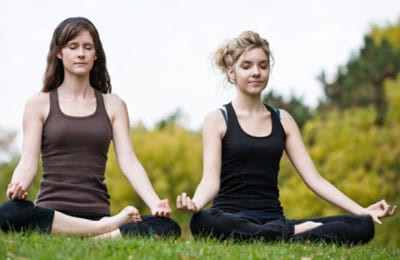You need not be a guru to appreciate the benefits of meditation. In addition to providing mental clarity, meditation can also relieve stress, encourage deep breathing, promote blood circulation, encourage healing and boost the flow of energy throughout your body. Beginning a meditation regime may seem daunting, but not everyone spends an hour in rapt silence daily. Try these simple techniques that are perfect for beginners to meditation and require little financial or time commitment.
Grounding
Grounding is one of the fundamentals in meditation, and a beginner can try grounding exercises in isolation or in conjunction with another type of meditation. The technique entails sitting comfortably–no lotus position required–with your shoes off and your feet on the ground. Rest your hands in your lap and close your eyes. Focus on the base of your spine. Visualize yourself outdoors, seated on a tree stump with roots that connect with your spine. The roots burrow to the center of the earth, joining you to the planet. Exhale and release tension through the roots. Try to let thoughts and worries drift away with the tension. Inhale and visualize the sun warming you, generating a sense of well-being. Try this for a minute or two at a time and build up to longer sessions.
Sitting Meditation
One of the most common types of meditation takes place while seated. Advanced practitioners may spend all day doing this, but beginners can try it for a shorter length of time. Begin in a calm space that is quiet. You can sit cross-legged on a pillow or however you are comfortable. Keep your eyes at least partially open or, if they are closed, ensure that the room is lit. Your goal is to keep mindfully present, not to sleep. Breathe and try practicing a grounding technique.
Sit-Stand Meditation
For those who wish to break up the monotony or discomfort of sitting meditation, it can be effective to incorporate standing. A classic pattern is to engage in three 15-minute sitting sessions that are interrupted by two minutes of standing. So that you do not focus on the passage of time, make a recording of a chime or gong to signal the time to stand. This is an introduction to the practice of active meditation.
Sweeping House
People who enjoy concrete methods for clearing the mind and body of stress love this beginner’s technique. Place your hands behind your head, resting them at the top of the neck. Briskly sweep your hands over your head, visualizing your thoughts being wiped to the top of your skull. When your hands are at your forehead, flick your fingers to chase away all those petty thoughts and voices in your head. You can repeat the motion several times. Some people modify this technique by adding a breathing technique. After sweeping house, place the palm of your dominant hand on your forehead and your other palm on the back of the dominant hand. Inhale deeply through your nostril several times, drawing oxygen to your core. Follow each inhale with a full exhale. After your last breath, sit still with your hands on your forehead and feel energy coursing through your body.
Cathartic Dancing Meditation
Cathartic dancing meditation is an energizing, ever-changing technique that is similar to shamanic rituals or ecstatic dance. The first stage is a 10-minute standing meditation. Keep your eyes closed and focus on deep breathing through your nostrils. You can sway, move or jump during this stage. The second stage is a 20-minute cathartic release of free-form dance. Involve the whole body and remember to keep breathing. Some people like to play instrumental or world music during this stage. You may also be verbal or scream during this stage. The third stage is a 10-minute session of quiet reflection. Lay down in a dead man’s pose and connect with the universe. This type of meditation is also great exercise.





